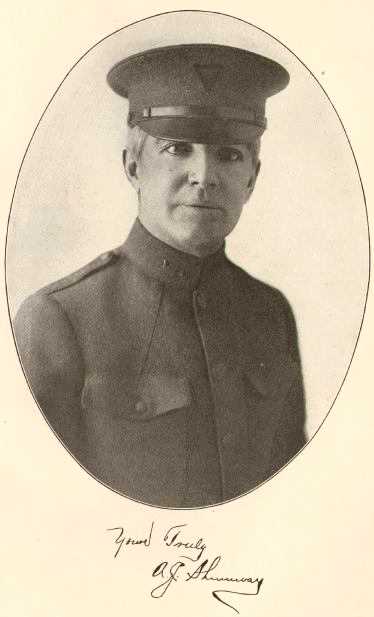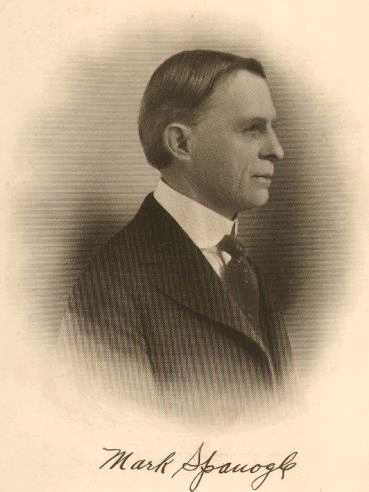  |
est active bankers in the north Platte valley and one of the best known men in Morrill county, having been cashier of the Bridgeport bank for twenty years. Ever since his arrival in Bridgeport he has taken an active part in the development of this section of the Panhandle; has been an indefatigable worker for the opening up of the valley; stood behind all movements for progress in all the varied industries of the county; and has helped turn the wheels of enterprise for the good of his community and Morrill county. Though practically a native of Nebraska, as he has spent the greatest part of his life in this state, Mr. Spanogle was born in Lewiston, Mifflin county, Pennsylvania, April 27, 1868, the son of Andrew and Margaret (Rice) Spanogle, who came west in 1879, reaching Hamilton county; Nebraska, on March 4th of that year. As a young boy Mr. Spanogle had attended school in his native state and after accompanying his parents to the new home in the west, he attended the frontier schools maintained in Hamilton county at that time, thus completing his elementary education. When only nineteen years of age he began his business career as bookkeeper in a bank at Phillips, Nebraska, in 1887. Having a natural aptitude for finance, he was rapidly advanced and, in 1892, was elected manager of the bank of Phillips, though very young to hold such a responsible position. From first entering the financial circles of the state Mr. Spanogle's career has been marked by executive ability, initiative, self-reliance, and progressiveness. His high standing has gained him popular confidence and esteem, which has furthered the success of every bank with which he has been associated. Matriculating in the law department of Drake University, Des Moines, Iowa, in 1892, Mr. Spanogle took this course with the idea of fitting himself still further for his business. He received his degree in 1894 and located in Clay county to practice law. Three years later he was elected county attorney of Clay county, serving in that office until the expiration of his term. In 1901, Mr. Spanogle came to the Panhandle, as he had long believed that this section of the state had a great future. Locating in Bridgeport, in August of that year, he was elected cashier of the Bridgeport bank on September 1st, a position which he has since continuously filled. Just two years after settling in the valley, Mr. Spanogle was elected attorney of Cheyenne county in 1903. Within a short period he became one of the organizers of the Union State bank of Broadwater, Nebraska, and, in 1917, was elected its president. Mr. Spanogle is the pioneer banker of the north Platte valley and his influence here has been wide and of great value to the people; for his policies have ever been constructive and of benefit in the development of every community where he has banking interests. When the question of dividing Cheyenne county came up, Mr. Spanogle was made chairman of the campaign committee which worked for the erection of Morrill county as a separate unit of the state. This was a long, hard fight and it was due to the able work and administrative ability of the chairman that in the end it was settled in an amicable manner. The new county was erected and no hard feeling remained between the people of old Cheyenne county and new Morrill county, and their relations have been cordial and happy ever since. When the selection of the seat of justice came up for Morrill county, Bayard made a hard fight for it and again Mr. Spanogle was called on to head the campaign to secure it for Bridgeport. It was due to his able management that Bridgeport became the county seat, and an easy winner in the contest. In 1904 Mr. Spanogle, Robert Willis, L. R. North, and Charles F. Clawgs became convinced that the rich alluvial soil of the valley was excellent for raising sugar beets; others were skeptical, and in order to convince people these men planted forty acres in beets. They knew little or nothing of sugar beet culture, were rank amateurs as farmers, but Colonel Atkins helped them, hired a crowd of high school boys to hoe the beets during the summer and in the fall when the crop had matured the beets were harvested, and shipped to Grand Island to the sugar factory. The test proved a great success and fully demonstrated that this section was a fine location for raising beets. From the date of shipping this first crop inquiries began to come in with regard to locating in the valley for beet growing. More settlers arrived, new farms were opened up, with the result that the country around Bridgeport is today one of the most highly productive, not only in western Nebraska but the whole country. Thousands of acres of land are now under cultivation that were virgin soil; more are and will be broken and sowed to beets. Four sugar factories are already in operation, with the prospect of others in the near future to care for the increasing crops; and much of this is due to the small group of men who had the enterprise and courage to go ahead and show what could be done in this district. The early irrigation projects in the valley had been largely by independent corporations, |
operating individually, all with different water rights and rates. As the new land was opened up and entered new methods were needed, and it soon became apparent that some general unified irrigation system was needed, as the old companies were all working on different plans and basis. It was necessary to enact new laws that would tend to unify the general system. When this was known, Mr. Spanogle was asked to assist in getting the different old companies to join with the new projects for a unified district and federal system, which was accomplished with little friction and for the benefit of all who bought water for irrigation. During the war Mr. Spanogle devoted much of his time to assisting the government in its prosecution. He was drafted as chairman of the Liberty Loan committee and was placed in charge of the western six counties of the state. His work was continuous and he prosecuted a vigorous campaign with the result that the Panhandle did its full share in buying bonds, due largely to his personal activities. April 22, 1899, Mr. Spanogle married Miss Gertrude L. Hurd, of Harvard, Nebraska, and since coming to Bridgeport they have been recognized as leaders of every communal movement for the development of the town. Mr. Spanogle is a member of the Masonic order, while his wife belongs to the Episcopal church. A hard worker, Mr. Spanogle is naturally a busy man, but never too much so to give a word of personal advice or listen to a proposition of benefit to Bridgeport or Morrill county. He has a host of warm friends and is known best to them as "Mark." A man of great constructive ability he has builded soundly and well for the upper valley, ever placing its welfare before his own personal affairs and interests. |
|
|
|
|
 |